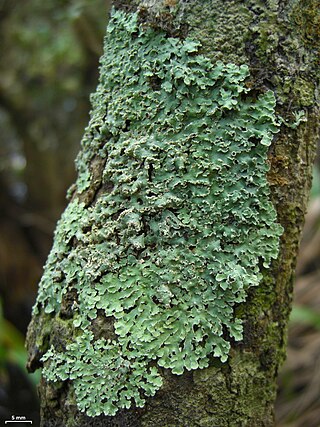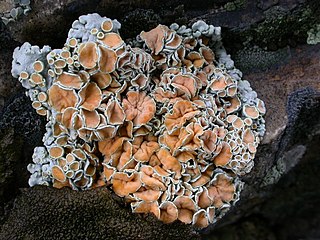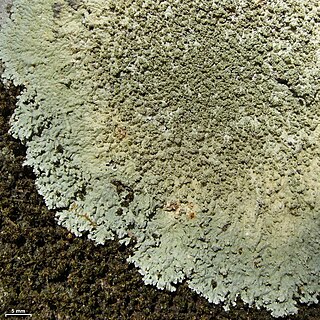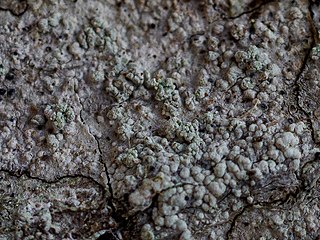
Physcia is a genus of lichen-forming fungi in the family Physciaceae. The widely distributed genus contains about 80 species. The genus is cosmopolitan, and has been extensively studied in various regions in the past several decades, with significant biodiversity in South America identified as a central diversity hotspot. Physcia species are foliose, lobate lichens that grow with a loose to close appressed habit. Their upper surface is typically whitish, pale greenish, green-grey, or dark grey in colour. The thallus colour remains relatively unchanged when moistened. Physcia lichens typically grow on bark, on wood, or rock, although they have occasionally been recorded dwelling on man-made structures. They thrive in nutrient-rich environments and are expanding rapidly in urban areas of the United Kingdom previously affected by SO2 pollution.
Xanthoparmelia maricopensis, the Maricopa rock-shield, is a 2–6 cm (0.8–2.4 in) wide, yellow-green foliose lichen in the Parmeliaceae family. It grows on igneous rock in southwestern North American deserts.

Lecanora muralis(Protoparmeliopsis muralis) is a waxy looking, pale yellowish green crustose lichen that usually grows in rosettes radiating from a center (placodioid) filled with disc-like yellowish-tan fruiting bodies (apothecia). It grows all over the world. It is extremely variable in its characteristics as a single taxon, and may represent a complex of species. The fruiting body parts have rims of tissue similar to that of the main nonfruiting body (thallus), which is called being lecanorine. It is paler and greener than L. mellea, and more yellow than L. sierrae. In California, it may be the most common member of the Lecanora genus found growing on rocks (saxicolous).

Xanthoparmelia mexicana, commonly known as the salted rock-shield, is a foliose lichen in the family Parmeliaceae. It grows in 4–10 cm diameter rosettes of gray-green to yellow-green lobes in arid climates all over the world.

Rhizoplaca chrysoleuca is a pale yellowish-green to gray-green umbilicate foiliose lichen in the Lecanoraceae family. It was first described in 1791 by English botanist Sir James Edward Smith as Lichen chrysoleucus; Friedrich Wilhelm Zopf transferred it to the genus Rhizoplaca in 1905.

Aspicilia cinerea is a gray to almost white, 1.5–15 cm (0.59–5.91 in) wide, crustose areolate lichen with large apothecia that mostly grows on rock in the mountains. It grows in variable forms, from having a continuous surface to being areolate. It grows in Eurasia, and North America on siliceous rock, schist or igneous rock in habitats exposed to sunlight, also rarely on calciferous rock. It is common in Arizona, and rare in California and Baja California at elevations of 1,700 to 3,300 metres.
Punctelia cedrosensis is a species of foliose lichen in the family Parmeliaceae. It is endemic to Mexico, where it grows on the bark of conifers.

Punctelia punctilla is a species of foliose lichen in the family Parmeliaceae. It is found in Africa, South America, and North America, where it grows on bark and on rocks. The main characteristics that distinguish Punctelia punctilla from other species of Punctelia are the presence of isidia on the thallus surface, a pale brown thallus undersurface, and the presence of lecanoric acid in the medulla.

Punctelia hypoleucites, commonly known as the southwestern speckled shield lichen, is a species of foliose (leafy) lichen in the family Parmeliaceae. First formally described by Finnish botanist William Nylander as a species of Parmelia, it was transferred to the genus Punctelia in 1982. The lichen is found in Africa, North America, and South America, where it grows on the bark of both hardwood and coniferous trees. Its greenish-grey thallus is covered with tiny white pseudocyphellae – minute holes in the thallus surface that facilitate gas exchange. Some macroscopic features that help distinguish this species from other related members of the genus include the presence and the structure of the apothecia, the absence of asexual surface propagules, and the light brown color of the thallus undersurface. Chemically, the presence of lecanoric acid in the medulla and atranorin in the cortex help distinguish it from lookalikes.
Parmotrema pustulotinctum is a rare species of foliose lichen in the family Parmeliaceae. Found on the Galápagos Islands, it was formally described s a new species in 2019 by lichenologists Frank Bungartz and Adriano Spielmann. The type specimen was collected from Santiago Island at an altitude of 362 m (1,188 ft), where it was found growing on an exposed vertical boulder. It is only known from the type collection. The species epithet refers to its isidia, that are pustulate and readily distinguishable from those of the closely related P. tinctorum.

Buellia oidalea is a species of crustose lichen found along the Pacific coast of North America, from Coos County, Oregon to Baja California Sur.
Buellia nashii is a species of lichen characterized by its crustose thallus, typically found in the Sonoran Desert Region and adjacent areas. It was first described by Bungartz et al. The species is named in honor of Dr. Thomas H. Nash III, a notable lichenologist and the Ph.D. supervisor of the author.
Buellia stellulata, commonly known as the disc lichen) is a species of crustose lichen that is widely distributed throughout the Northern Hemisphere.

Dirinaria aegialita is a species of foliose lichen in the family Caliciaceae. It is found in tropical regions around the world, with scattered occurrences in subtropical North America.
Dirinaria neotropica is a species of lichen belonging to the genus Dirinaria within the family Caliciaceae. It was described by Kalb in 2004.

Dirinaria confusa is a species of fungus within the family Caliciaceae, belonging to the order Caliciales in the class Lecanoromycetes of the division Ascomycota.

Dirinaria picta is a species of lichen within the family Caliciaceae, classified under the order Caliciales in the class Lecanoromycetes of the division Ascomycota.
Dirinaria frostii is a species of lichen in the family Caliciaceae. It is commonly found in the southeastern United States and Sonora, Mexico. The species was first described by Tuckerman and later classified by Hale & Culberson.

Buellia griseovirens is a species of lichen belonging to the family Caliciaceae. It exhibits a crustose growth type and is commonly found on well-lit, smooth bark, and worked timber surfaces. The species can tolerate moderate pollution.

Buellia aethalea is a species of lichen that belongs to the family Caliciaceae. It is commonly known as darkened button lichen, and Buellie noircie in French. The lichen's familiar nickname is inspired by the appearance of its surface, adorned with small black spots reminiscent of buttons.













